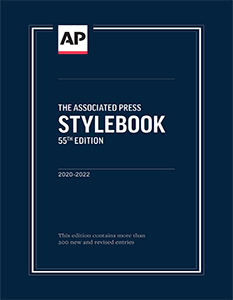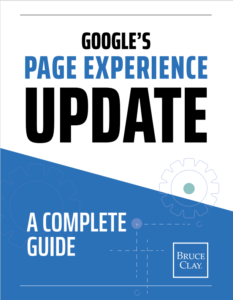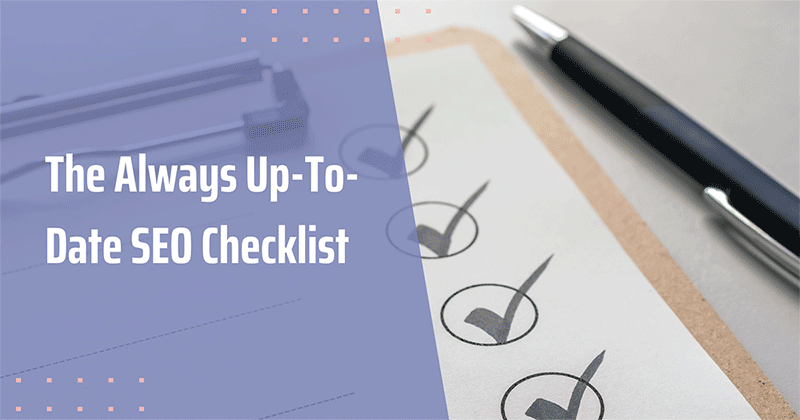What Makes a Webpage Quality?

SEO rule No. 1: You don’t want to put low-quality webpages out into the world. That’s not a good presentation of your brand and quite frankly, they just won’t rank.
But what actually determines webpage quality? I’ll outline the various aspects that impact the perceived quality of a webpage, by both search engines and users, in the following sections:
- Experience, Expertise, authority, and trust
- Journalistic integrity in your content
- Content optimization
- Technical SEO
- Tips for consistently improving webpage quality
- FAQ: How can I ensure my webpages maintain high-quality standards for better search engine performance?
Experience, Expertise, Authority, and Trust
Google is notoriously protective of its search ranking algorithm. As a result, much of what we accept as best practice in SEO is based on educated guesses, experience, and simply seeing what works.
When it comes to on-page SEO and what Google is looking for in a quality webpage, though, they’ve been surprisingly transparent. In its Search Quality Evaluator Guidelines (SQEG), the search giant shares what its search quality raters should consider as indicative of page quality.
The SQEG explains the following are the most important factors for quality raters to consider in determining a page’s quality rating:
- The purpose of the page
- Experience, expertise, authoritativeness, trustworthiness
- Main content quality and amount
- Website information or information about who is responsible for the main content
- Website reputation or reputation of the person responsible for the main content
That second one — expertise, authoritativeness, and trustworthiness, also known as E-E-A-T — is so important that it appears a whopping 130 times in the SQEG.
While not a ranking factor, E-E-A-T is a great framework by which to gauge the quality of your content. Specifically, Google advises that its raters consider the E-E-A-T of the people who create the content, the content itself, and the website as a whole.
Here’s what the SQEG says to consider:
- The expertise of the creator of the main content
- The authoritativeness of the creator of the main content, the main content itself, and the website
- The trustworthiness of the creator of the main content, the main content itself, and the website
Again, this isn’t a part of the core algorithm. Rather, parts of the core algorithm look for E-E-A-T signals; for example, I believe that the Panda update was about expertise, Penguin was about authority, and Medic was about trust.
How can you make sure your webpages are trustworthy and authoritative, showcasing your expertise? For this next tip, I take a page from the most experienced content creators out there.
Journalistic Integrity in Your Content
Even if you’re fairly confident that the information you’re sharing is accurate, it’s important that you make it easy for Google (and your readers) to verify it. Journalists have “Cite your sources!” drilled into their heads from the earliest days of training.
Fact-checking should be an integral part of your publishing process. In fact, Google cares about this to the extent it provides a fact-checking tool that enables searchers to input a claim and see what’s been verified about it online.
Always consider the expertise, authoritativeness, and trustworthiness of the sources you’re citing on your webpage, too. Restating something as fact is your personal endorsement of that information.

Another important tool for improving the quality of your content is to choose a style guide to go by. Adhering to one style guide gives your content clarity and consistency. For example, the Associated Press Stylebook is the style that journalists use when they write content.
Sticking with one style tells all of your writers, editors, marketers, and others who publish content on-site how to handle links and citations, capitalization in titles and subheadings, punctuation, presentation of statistics, and more.
Essentially, you want readers and visitors focused on your quality content, not trying to overlook omissions or inconsistencies in how the information is presented.
Which style guide you choose is up to you, and in fact, many organizations create their own style guide to maintain consistency. That’s great, too. What matters most is that you choose one and apply it to all of your web content.
Content Optimization
Once you’re satisfied with the quality and accuracy of the content on your webpage, it’s important that you optimize it. How else will Google understand that your webpage is the best answer for relevant queries?
I won’t go into great detail here, as we have an excellent, always up-to-date SEO checklist here. Work through it as you optimize new content, and soon, it’ll become second nature.
Technical SEO
We’ve focused heavily on content and other on-page SEO factors to this point. But even the best content will underperform without the solid underpinning of a technically sound website.
Technical SEO is the practice of optimizing your website so Google and other search engines can easily crawl and index your webpages. It also applies to user experience in that visitors expect webpages to load quickly and smoothly.
Google aims to give each searcher the best answer for their need, and these technical SEO considerations are part of that experience:

Site Speed
How fast your webpage loads has a massive impact on your visitor’s experience — and the actions they will take as a result.
Google’s research shows that “…faster mobile site speed makes people view more pages on the site, convert more, and buy more on most brand sites.”
Page speed has long been a ranking factor, but speed and other core metrics have grown in importance with Google’s 2021 page experience update.
Learn more about how to make your site faster: How Fast Should My Webpage Be and Why Should I Care?
Mobile-Friendliness
Is your site responsive to the device on which the visitor is viewing it?
Does your page load quickly on mobile, and is content formatted for easy reading on different screen sizes?
These are major considerations for Google and in fact, mobile-friendliness is a ranking signal within the page experience update. This impactful update also includes:
- Core Web Vitals, a set of three metrics that help Google understand the experience visitors have on any given webpage: Largest Contentful Paint, Cumulative Layout Shift, and First Input Delay
- HTTPS compliance for secure browsing status
- Intrusive interstitials — specifically, ensuring that you don’t have any
There are many technical factors that can impact your site’s mobile-friendliness — responsive design, properly configured text and buttons, and page loading speed, among them. See Page Experience Matters: The Mobile-Friendly Site to learn more.
A whole host of issues may impact Google’s ability to find, crawl, and index your webpage. Cloaking, redirects, 404 errors, robots.txt status and more are among the more common technical SEO issues that could impact your website quality.
Check out these Technical SEO Tips to learn more about optimizing the back end of your site.
Tips for Consistently Improving Webpage Quality
As you apply best practices and begin looking at all pages through a quality lens, the process will become faster and easier. Run through this list of tips with one of your existing pages and see where you can improve:
- Focus on demonstrating E-E-A-T in all of your content — written copy, photos, videos, and other elements, too.
- Remember that the reputation of the content creator and website as a whole matters. Include the author’s name, a short bio (either on-page or linked), and links to social profiles.
- Fact-check all information and statistics, citing your sources in accordance with the style guide of your choice.
- Ensure that the page’s content delivers on the expectation a reader will have upon navigating to that page from the SERP.
- Proofread carefully! Don’t let simple typos or small errors take away from your page’s perceived quality.
- Create a sufficient amount of content and include enough information to satisfy the need that brought the searcher to your page. (Our WordPress SEO plugin can help you know how much to write in order to compete.)
- Optimize content to help Google understand how and why that webpage meets the needs of searchers using relevant queries.
- Make sure preventable technical SEO issues aren’t standing in the way of your page’s accessibility and rankings.
Making a quality website is impossible without SEO-friendly, high-quality content. At Bruce Clay Inc., we have a team of experienced writers who can help meet your needs. Interested in learning more about our content development services? Contact us for a free consultation today.
FAQ: How can I ensure my webpages maintain high-quality standards for better search engine performance?
Maintaining a high level of quality for your webpages is pivotal for driving better search engine performance. In an era where user experience is paramount, search engines like Google are placing increased emphasis on ranking pages that offer genuine value. To ensure your webpages meet these high-quality standards and deliver exceptional results, consider the following strategies:
Prioritize Content Relevance
Craft content that aligns precisely with your audience’s needs. In-depth research into your target audience’s preferences and pain points will help you create content that resonates and provides genuine value.
Incorporate E-E-A-T Principles
Experience, expertise, authority, and trustworthiness (E-A-T) are foundational for high-quality webpages. Showcase your expertise by offering well-researched insights, share your personal experiences and opinions with the subject matter, back your claims with authoritative sources, and foster trust by maintaining transparent and reliable content.
Implement On-Page Optimization
Optimize your content for both users and search engines. Pay attention to title tags, meta descriptions, header tags, and keyword placement. Balancing keyword usage with natural readability is key to maintaining high quality.
Streamline User Experience
User experience directly influences search engine performance. Ensure fast page loading times, responsive design for various devices, and easy navigation. Users should be able to find what they need without any friction.
Focus on Technical SEO
Technical SEO forms the backbone of webpage quality. Prioritize tasks like improving site speed, optimizing images, and ensuring mobile-friendliness. These factors enhance both user experience and search engine rankings.
Transitioning seamlessly between these strategies is essential for maintaining a cohesive approach to webpage quality. By prioritizing content relevance, incorporating E-E-A-T principles, optimizing on-page elements, streamlining the user experience, and emphasizing technical SEO, you can effectively elevate your webpage quality and secure better search engine performance.
Step-by-Step Procedure: Strategies to Enhance Webpage Quality for Improved Search Engine Performance
- Conduct thorough audience research to understand their preferences and pain points.
- Align content topics with audience needs to ensure relevance.
- Utilize authoritative sources to back up claims and enhance expertise.
- Provide clear author credentials to establish authority and trustworthiness.
- Craft compelling title tags and meta descriptions that accurately represent content.
- Use header tags to structure content for easy readability and navigation.
- Integrate relevant keywords naturally into the content.
- Optimize images for fast loading times and improved user experience.
- Ensure responsive design to guarantee usability across various devices.
- Implement a content delivery network (CDN) to enhance page loading speed.
- Conduct regular site audits to identify and resolve technical SEO issues.
- Create XML sitemaps to aid search engine crawling and indexing.
- Improve site speed by compressing images and minimizing server response time.
- Eliminate duplicate content issues to enhance content uniqueness.
- Implement schema markup to enhance search engine understanding of content.
- Monitor user behavior and make adjustments based on analytics data.
- Regularly update content to ensure accuracy and relevance.
- Engage in reputable link-building practices to enhance authority.
- Collaborate with industry influencers to gain credibility and exposure.
- Continuously monitor search engine algorithm updates and adapt strategies accordingly.
This article was updated on December 19, 2023.

8 Replies to “What Makes a Webpage Quality?”
You opened my eyes, these things I was missing on my website and I didn’t knew. Better to ask my outsourced digital marketing agency to implement them ASAP.
Hey, I read your content and this was amazing. Especially this “I won’t go into great detail here, as we have an excellent, always up-to-date SEO checklist here. Work through it as you optimize new content, and soon it’ll become second nature.
LEAVE A REPLY









